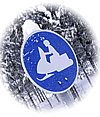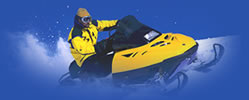|
|
 |
|
 Snowmobile
Safety Reduces The Risk Snowmobile
Safety Reduces The Risk
While
snowmobiling is fun, it is accompanied by many natural challenges
and risks. Snow conditions, wind, sun, glare, cold, vibration,
motion and other factors work together to affect both driver
and passenger. What's more, it takes place off-road in an
unpredictable and uncontrollable natural setting, often far
from emergency assistance. So make these smart choices to
arrive home safely after every ride:
|
 |
| |
Practice
Zero Alcohol |
| |
 |
We could
fill an entire web site with statistics, situations and stories
on this subject. Alcohol magnifies and distorts the challenges
associated with riding. Simply put, alcohol and snowmobiling
do not mix. The Zero Alcohol position endorsed by
organized snowmobiling means avoiding any consumption before
or during any ride. Operating your sled under the influence
of alcohol is punishable under the Criminal Code of Canada.
If convicted of driving a snowmobile while impaired, you could
lose all driving privileges (car, truck, motorcycle, off-road
vehicles and snowmobiles).
|
| |
 |
| Stay
on the Trail |
 |
Organized
snowmobiling associations have many marked, mapped and maintained
approved trails and riding areas for your enjoyment. By sticking
to these designated snowmobiling locations and staying off
roads, lakes and private property, you can greatly reduce
your risk of getting into trouble.
Beware
of Ice: The rule is know before you go. Riding into open
water or falling through the ice are the most obvious risks,
but collisions with fixed objects are also prevalent. What's
more, your sled has less traction for starting, turning and
stopping on ice than on snow. If you must cross on the ice,
know before you go and only cross where there is a stake line
maintained by local snowmobile clubs.
Avoid
Avalanches: Any snow-loaded slope has the potential to
slide in certain snow, wind and temperature conditions. So
once again, the rule is know before you go. Take a course,
carry and practice using probe, shovel and transceiver, and
always check the latest avalanche bulletins before leaving
home. Avoid avalanche prone slopes or parking in potential
slide paths, and always cross any slope one at a time. Never
ride up to help a sled stuck on a slope, which could trigger
an avalanche.
|
|

|
| Slow
Down at Night |
 |
Darkness
reduces visibility and alters perceptions, so riding at night
is much more risky than during the day, especially if alcohol
and speed are also involved. Change your riding approach to
account for night dangers and be very careful not to outrun
your headlights so you can see far enough ahead to stop safely.
Take
It Easy: Always ride with care and control so that you
can avoid getting into trouble. Take it easy also means expecting
the unexpected and avoiding unnecessary risks. Always adjust
your speed to the trail, light and weather conditions and
come to a complete stop at all road crossings. Before proceeding,
make absolutely sure that no traffic is approaching from any
direction. Always cross at a right angle to traffic.
|
 |
| Get
Trained |
 |
Before
you go snowmobiling, take the time to learn the rules of the
trail, how to ride properly and about operating your sled.
Many snowmobile organizations offer driver training courses
and your sled's manual also provides valuable tips.
Wear
The Gear: Specialized snowmobiling gear includes suit,
boots and gloves designed to keep you warm while riding and
with reflective trim to be seen at night. Most important,
always wear a properly fitted and approved snowmobile helmet,
with the chin strap securely fastened and the visor down or
goggles in place while riding.
|
 |
| Be
Prepared |
 |
Snowmobiling
can take you far away from emergency assistance, so be prepared
to help yourself by carrying a tool kit, spare parts, flashlight,
first-aid kit and a few survival items such as high-energy
food, fire-starting equipment and a compass. While cell service
may not be available, a SPOT unit or satellite phone is useful
in an emergency. Leaving a snow plan behind one with someone
responsible can be lifesaving. Make sure it describes where
you will be riding and always let that person know when you're
due back or expected to arrive at your destination.
|
 |
| Ride
With Companions |
 |
Never
snowmobile alone. Too much can go wrong very quickly if you
are all alone. Besides, riding with friends and family is
way more fun - and those extra bodies can assist if you break
down or get stuck. Just make sure that peer pressure doesn't
lure you into taking foolish risks with the rest of your pack!
|
 |
| Ride
Defensively |
 |
Engine
noise and your helmet may impair your hearing, while blowing
snow or snow dust can reduce vision so be extra alert for
danger. Never assume what another rider will do. Your safety
is in your hands, so watch out for:
-
Obstacles
hidden by the snow
-
Trees
and branches on the trail
-
Slow
grooming equipment
-
Oncoming
sleds
-
Other
trail users (skiers, walkers)
-
Wildlife
-
Trail
wash outs and flooding
-
Snow
banks and moguls
-
Road
and railway crossings
-
Unexpected
corners, intersections and stops
-
Bridges,
open water and unsafe ice
|
|
|

